M. QUELQUE CHOSE
Exposition collective autour des dessins du poète Jean Follain.
Avec Beatriz Olabarrieta, Yonatan Vinitsky, Ola Vasiljeva.
Une exposition de It’s Our Playground.
8 septembre - 28 octobre 2018
Il y a quelque chose de fondamentalement normal dans les objets, les vêtements, les lieux décrits par Jean Follain dans ses poèmes ou textes en prose. Le talent du poète né en Normandie en 1903, réside dans sa façon d’écrire le réel avec humilité, sans image ni métaphore, à contretemps du surréalisme dont il est contemporain. Les écrits de Jean Follain se situent entre tradition et modernité, entre la campagne et la ville, entre Canisy, Saint-Lô et Paris. Sa poésie témoigne d’une attention de chaque instant à son environnement quotidien : la forme d’un verre, le revers d’un col, le nez en trompette du garçon de café, autant de détails ténus qui viendront éblouir l’accumulateur compulsif qu’il était.
Lors de nos recherches, nous découvrons ses manuscrits de poèmes au milieu d’autres documents d’une banalité frappante : des sous-bocks, des morceaux de nappe de bistrot, du papier à entête, pour la plupart ornés du trait libre de Jean Follain. Un homme cravaté affublé d’une paire d’antennes, des dizaines de portraits de moustachus, un escargot de compagnie, un homme portant une jupe, ces dessins de rêverie, malgré le papier jauni et corné, semblent appartenir au présent. Dans cette exposition, ces dessins réalisés dans un contexte privé seront majoritairement détachés des écrits sans pour autant être considérés comme des œuvres d’art. Présentés sur des tables évoquant leur mode d’apparition, ils pourront ainsi pour la première fois être considérés comme une pratique à part entière, appréciés pour leur qualité indéniable. Est-ce l’élégance de la plume d’un homme fréquentant de nombreux artistes ou le trait sûr du stylo à bille ne semblant pas quitter la feuille qui confèrent aux dessins de Follain cet aspect si contemporain ?
M. Quelque chose met en regard les dessins du poète normand avec le travail de trois artistes contemporains : Beatriz Olabarrieta, Ola Vasiljeva et Jonathan Vinitsky. Ceux-ci ont d’abord en commun l’utilisation de la figure humaine comme élément vecteur de sens et d’humeur. Leurs formes modestes, suggérant des silhouettes nous attirent sans que l’on ne puisse vraiment les saisir. Tout comme Jean Follain, c’est souvent dans la littérature, les événements historiques ou le rêve que Ola Vasiljeva puise l’inspiration nécessaire à la réalisation de ses environnements complexes mêlant dessin, sculpture, objets trouvés et vidéo. Les dessins exposées ici représentent des figures humaines ou des patrons de vêtements qui flirtent avec la forme sculpturale.
Les installations de Beatriz Olabarrieta évoquent une dramaturgie du quotidien et une occupation de l’espace par des figures anthropomorphes bavardes et fragmentaires. A travers une cosmologie d’objets et de formes qui se joue des contingences du présent, le trait devient alors le langage de ce que l’on ne peut mettre en mots.
À l’origine de chaque nouveau projet de Yonatan Vinitsky il y a un objet domestique apparemment anodin, une image trouvée lors de phases de recherches, le choix d’une technique ou d’un matériaux particuliers. L’artiste porte une attention particulièrement amusée à l’histoire de l’art et les choses qui l’entourent. A force d’appropriations et de citations, il dresse ainsi son panthéon de références, piochant aussi bien dans l’histoire du Bauhaus que dans des images publicitaires, sans distinction ni hiérarchie.
Cette exposition sera donc l’occasion d’une rencontre inattendue entre les dessins d’ennui d’un poète normand du siècle dernier et les œuvres contemporaines de trois artistes internationaux partageant un regard précis et poétique sur le monde qui les entoure.
----------------------
Jean Follain (né en 1903 à Canisy, décédé en 1971 à Paris) s'installe à Paris en 1925 et s'inscrit au barreau en 1928. Menant une double carrière de magistrat et d'écrivain, il se lie avec les membres du groupe « Sagesse » et reçoit le Prix Mallarmé en 1939. Écrivant en dehors du surréalisme, poète de l'objet, il a contribué à forger une poésie nouvelle (Usage du temps, Exister). Il reçoit en 1970 le Grand Prix de poésie de l'Académie française.
Beatriz Olabarrieta (née en 1979 à Bilbao) vit et travaille à Berlin. Ses projets récents incluent The Only Way Out Is In, à The Sunday Painter, Londres, 2017 ; Clever To Follow Goat, chez Antoine Levi, Paris, 2017 ; Los Algoritmos Suaves (exposition de groupe curatée par Rafael Barber Cortell) au Centre Del Carme, Valencia, 2018.
Ola Vasiljeva (née en 1981 à Ventspils, Lettonie) vit et travaille aux Pays-Bas. Ses projets récents incluent Song and Love (avec Matthew Lutz-Kinoy) à Indipendenza, Rome, 2018 ; Qualcuno si è seduto sulla mia sedia, à Quartz Studio, Turin, 2018 ; The Decline of the Showpieces à la Grazer Kunstverein, 2018 ; Zefiro Torna, au Centre d'art contemporain Passerelle, Brest, 2017.
Yonatan Vinitsky (né en 1980 à Jérusalem) vit et travaille à Londres. Ses projets récents incluent After 12 comes 1, à la galerie Braverman, Tel Aviv, 2016 ; Sortie Définitive, à Mon Chéri, Brussels, 2015 ; Loose Ends, à la galerie Frutta, Rome, 2015.
Exposition collective autour des dessins du poète Jean Follain.
Avec Beatriz Olabarrieta, Yonatan Vinitsky, Ola Vasiljeva.
Une exposition de It’s Our Playground.
8 septembre - 28 octobre 2018
Il y a quelque chose de fondamentalement normal dans les objets, les vêtements, les lieux décrits par Jean Follain dans ses poèmes ou textes en prose. Le talent du poète né en Normandie en 1903, réside dans sa façon d’écrire le réel avec humilité, sans image ni métaphore, à contretemps du surréalisme dont il est contemporain. Les écrits de Jean Follain se situent entre tradition et modernité, entre la campagne et la ville, entre Canisy, Saint-Lô et Paris. Sa poésie témoigne d’une attention de chaque instant à son environnement quotidien : la forme d’un verre, le revers d’un col, le nez en trompette du garçon de café, autant de détails ténus qui viendront éblouir l’accumulateur compulsif qu’il était.
Lors de nos recherches, nous découvrons ses manuscrits de poèmes au milieu d’autres documents d’une banalité frappante : des sous-bocks, des morceaux de nappe de bistrot, du papier à entête, pour la plupart ornés du trait libre de Jean Follain. Un homme cravaté affublé d’une paire d’antennes, des dizaines de portraits de moustachus, un escargot de compagnie, un homme portant une jupe, ces dessins de rêverie, malgré le papier jauni et corné, semblent appartenir au présent. Dans cette exposition, ces dessins réalisés dans un contexte privé seront majoritairement détachés des écrits sans pour autant être considérés comme des œuvres d’art. Présentés sur des tables évoquant leur mode d’apparition, ils pourront ainsi pour la première fois être considérés comme une pratique à part entière, appréciés pour leur qualité indéniable. Est-ce l’élégance de la plume d’un homme fréquentant de nombreux artistes ou le trait sûr du stylo à bille ne semblant pas quitter la feuille qui confèrent aux dessins de Follain cet aspect si contemporain ?
M. Quelque chose met en regard les dessins du poète normand avec le travail de trois artistes contemporains : Beatriz Olabarrieta, Ola Vasiljeva et Jonathan Vinitsky. Ceux-ci ont d’abord en commun l’utilisation de la figure humaine comme élément vecteur de sens et d’humeur. Leurs formes modestes, suggérant des silhouettes nous attirent sans que l’on ne puisse vraiment les saisir. Tout comme Jean Follain, c’est souvent dans la littérature, les événements historiques ou le rêve que Ola Vasiljeva puise l’inspiration nécessaire à la réalisation de ses environnements complexes mêlant dessin, sculpture, objets trouvés et vidéo. Les dessins exposées ici représentent des figures humaines ou des patrons de vêtements qui flirtent avec la forme sculpturale.
Les installations de Beatriz Olabarrieta évoquent une dramaturgie du quotidien et une occupation de l’espace par des figures anthropomorphes bavardes et fragmentaires. A travers une cosmologie d’objets et de formes qui se joue des contingences du présent, le trait devient alors le langage de ce que l’on ne peut mettre en mots.
À l’origine de chaque nouveau projet de Yonatan Vinitsky il y a un objet domestique apparemment anodin, une image trouvée lors de phases de recherches, le choix d’une technique ou d’un matériaux particuliers. L’artiste porte une attention particulièrement amusée à l’histoire de l’art et les choses qui l’entourent. A force d’appropriations et de citations, il dresse ainsi son panthéon de références, piochant aussi bien dans l’histoire du Bauhaus que dans des images publicitaires, sans distinction ni hiérarchie.
Cette exposition sera donc l’occasion d’une rencontre inattendue entre les dessins d’ennui d’un poète normand du siècle dernier et les œuvres contemporaines de trois artistes internationaux partageant un regard précis et poétique sur le monde qui les entoure.
----------------------
Jean Follain (né en 1903 à Canisy, décédé en 1971 à Paris) s'installe à Paris en 1925 et s'inscrit au barreau en 1928. Menant une double carrière de magistrat et d'écrivain, il se lie avec les membres du groupe « Sagesse » et reçoit le Prix Mallarmé en 1939. Écrivant en dehors du surréalisme, poète de l'objet, il a contribué à forger une poésie nouvelle (Usage du temps, Exister). Il reçoit en 1970 le Grand Prix de poésie de l'Académie française.
Beatriz Olabarrieta (née en 1979 à Bilbao) vit et travaille à Berlin. Ses projets récents incluent The Only Way Out Is In, à The Sunday Painter, Londres, 2017 ; Clever To Follow Goat, chez Antoine Levi, Paris, 2017 ; Los Algoritmos Suaves (exposition de groupe curatée par Rafael Barber Cortell) au Centre Del Carme, Valencia, 2018.
Ola Vasiljeva (née en 1981 à Ventspils, Lettonie) vit et travaille aux Pays-Bas. Ses projets récents incluent Song and Love (avec Matthew Lutz-Kinoy) à Indipendenza, Rome, 2018 ; Qualcuno si è seduto sulla mia sedia, à Quartz Studio, Turin, 2018 ; The Decline of the Showpieces à la Grazer Kunstverein, 2018 ; Zefiro Torna, au Centre d'art contemporain Passerelle, Brest, 2017.
Yonatan Vinitsky (né en 1980 à Jérusalem) vit et travaille à Londres. Ses projets récents incluent After 12 comes 1, à la galerie Braverman, Tel Aviv, 2016 ; Sortie Définitive, à Mon Chéri, Brussels, 2015 ; Loose Ends, à la galerie Frutta, Rome, 2015.
M. QUELQUE CHOSE
There is something fundamentally normal in the objects, clothing, and places described by Jean Follain in his poems and prose texts. The talent of this poet, who was born in Normandy in 1903, lies in his way of humbly writing about reality without employing images or metaphors. He was a contemporary of the Surrealists and yet his work was not of the same time as the movement. Follain’s writings exist between tradition and modernity, the countryside and the city, Canisy, Saint-Lô, and Paris. The poetry shows this writer’s attention, with each passing instant, to his daily surroundings. The form of a glass, the lapel of a collar, the turned-up nose of the waiter – so many slight details that would come together and dazzle the hoarder he was.
In the course of our research we discovered many manuscripts of his poems scattered among other documents that are striking for their utter banality. Beer coasters, bits of paper table covers from the local pub, letterhead paper, most of these documents are adorned with Follain’s free-flowing line. A man shown sporting a tie and decked out with a pair of antennae, dozens of portraits of moustachioed faces, a pet snail, a man wearing a skirt – despite the yellowed and dog-eared paper, these dream drawings seem to belong to the present. In this exhibition, the drawings, which were executed in a private context, were for the most part separate from the writings but were not considered works of art. Displayed on tables suggesting how they originally appeared, they can now be seen for the first time as forming an art practice in their own right, appreciated for their quality, which is immediately obvious. Is it the elegance of a pen wielded by a man who spent long hours with numerous artist friends, or the steady line of the ballpoint that never seems to break contact with the surface of the paper that imbues Follain’s drawings with such a contemporary look?
M. Quelque chose (Mr. Something) presents side by side the Norman poet’s drawings and the work of three artists working today, Beatriz Olabarrieta, Ola Vasiljeva, and Jonathan Vinitsky. The latter have in common their distinctive use of the human figure as a vector of meaning and humor. Their modest forms, suggesting a series of silhouettes, catch the eye, which still can’t quite grasp them. Just like Jean Follain, Ola Vasiljeva often draws her inspiration from literature, historical events, or dreams, an inspiration that is necessary for her complex installations that combine drawing, sculpture, found objects, and video. The drawings featured here depict human figures or clothing patterns that flirt with sculptural forms.
Beatriz Olabarrieta’s installations evoke the drama of daily life and an occupation of space by talkative and fragmentary anthropomorphic figures. Through a cosmology of objects and forms that plays games with the contingencies of the present, the line becomes the language of that which cannot be put into words.
And at the start of each new project that Yonatan Vinitsky undertakes, there is an apparently harmless household object, an image found during the research phases of an artwork, the choice of a particular technique or material. The artist takes a particularly amused view of art history and the things surrounding it. Through numerous appropriations and quotations, he builds up his pantheon of references, delving into the history of Bauhaus as much as images used in advertising, and without distinction or hierarchy.
The show is thus the occasion for an unexpected meeting, that is, drawings that sprang from the ennui of a Norman poet working in the last century, and altogether contemporary pieces by three international artists who share a precise, poetic view of the world around them today.
----------------------
Jean Follain (born in 1903 in Canisy, died in 1971 in Paris) settled in Paris in 1925 and passed the bar in 1928. Leading a dual career as a judge and a writer, he was friends with the members of the “Sagesse” (Wisdom) group and was awarded the Prix Mallarmé in 1939. Writing outside of the Surrealist movement, this poet of the object helped to forge a new poetry (Usage du temps, Exister). In 1970 he was given the Grand Prix de poésie by the French Academy.
Beatriz Olabarrieta (Born 1979 in Bilbao) lives and works in Berlin. Recent projects include The Only Way Out Is In, at The Sunday Painter, London, 2017 ; Clever To Follow Goat, at Gallery Antoine Levi, Paris, 2017 ; Los Algoritmos Suaves (a group show curated by Rafael Barber Cortell) at Centre Del Carme, Valencia, 2018.
Ola Vasiljeva (Born 1981 in Ventspils, Latvia) lives and works in the Netherlands. Recent projects include Song and Love (with Matthew Lutz-Kinoy) at Indipendenza, Rome, 2018 ; Qualcuno si è seduto sulla mia sedia, at Quartz Studio, Turin, 2018 ; The Decline of the Showpieces à la Grazer Kunstverein, 2018 ; Zefiro Torna, at Passerelle Contemporary Art Center, Brest, 2017.
Yonatan Vinitsky (Born 1980 in Jérusalem) lives and works in London. Recent projects include After 12 comes 1, at Braverman Gallery, Tel Aviv, 2016 ; Sortie Définitive, at Mon Chéri, Brussels, 2015 ; Loose Ends, at Frutta Gallery, Rome, 2015.
There is something fundamentally normal in the objects, clothing, and places described by Jean Follain in his poems and prose texts. The talent of this poet, who was born in Normandy in 1903, lies in his way of humbly writing about reality without employing images or metaphors. He was a contemporary of the Surrealists and yet his work was not of the same time as the movement. Follain’s writings exist between tradition and modernity, the countryside and the city, Canisy, Saint-Lô, and Paris. The poetry shows this writer’s attention, with each passing instant, to his daily surroundings. The form of a glass, the lapel of a collar, the turned-up nose of the waiter – so many slight details that would come together and dazzle the hoarder he was.
In the course of our research we discovered many manuscripts of his poems scattered among other documents that are striking for their utter banality. Beer coasters, bits of paper table covers from the local pub, letterhead paper, most of these documents are adorned with Follain’s free-flowing line. A man shown sporting a tie and decked out with a pair of antennae, dozens of portraits of moustachioed faces, a pet snail, a man wearing a skirt – despite the yellowed and dog-eared paper, these dream drawings seem to belong to the present. In this exhibition, the drawings, which were executed in a private context, were for the most part separate from the writings but were not considered works of art. Displayed on tables suggesting how they originally appeared, they can now be seen for the first time as forming an art practice in their own right, appreciated for their quality, which is immediately obvious. Is it the elegance of a pen wielded by a man who spent long hours with numerous artist friends, or the steady line of the ballpoint that never seems to break contact with the surface of the paper that imbues Follain’s drawings with such a contemporary look?
M. Quelque chose (Mr. Something) presents side by side the Norman poet’s drawings and the work of three artists working today, Beatriz Olabarrieta, Ola Vasiljeva, and Jonathan Vinitsky. The latter have in common their distinctive use of the human figure as a vector of meaning and humor. Their modest forms, suggesting a series of silhouettes, catch the eye, which still can’t quite grasp them. Just like Jean Follain, Ola Vasiljeva often draws her inspiration from literature, historical events, or dreams, an inspiration that is necessary for her complex installations that combine drawing, sculpture, found objects, and video. The drawings featured here depict human figures or clothing patterns that flirt with sculptural forms.
Beatriz Olabarrieta’s installations evoke the drama of daily life and an occupation of space by talkative and fragmentary anthropomorphic figures. Through a cosmology of objects and forms that plays games with the contingencies of the present, the line becomes the language of that which cannot be put into words.
And at the start of each new project that Yonatan Vinitsky undertakes, there is an apparently harmless household object, an image found during the research phases of an artwork, the choice of a particular technique or material. The artist takes a particularly amused view of art history and the things surrounding it. Through numerous appropriations and quotations, he builds up his pantheon of references, delving into the history of Bauhaus as much as images used in advertising, and without distinction or hierarchy.
The show is thus the occasion for an unexpected meeting, that is, drawings that sprang from the ennui of a Norman poet working in the last century, and altogether contemporary pieces by three international artists who share a precise, poetic view of the world around them today.
----------------------
Jean Follain (born in 1903 in Canisy, died in 1971 in Paris) settled in Paris in 1925 and passed the bar in 1928. Leading a dual career as a judge and a writer, he was friends with the members of the “Sagesse” (Wisdom) group and was awarded the Prix Mallarmé in 1939. Writing outside of the Surrealist movement, this poet of the object helped to forge a new poetry (Usage du temps, Exister). In 1970 he was given the Grand Prix de poésie by the French Academy.
Beatriz Olabarrieta (Born 1979 in Bilbao) lives and works in Berlin. Recent projects include The Only Way Out Is In, at The Sunday Painter, London, 2017 ; Clever To Follow Goat, at Gallery Antoine Levi, Paris, 2017 ; Los Algoritmos Suaves (a group show curated by Rafael Barber Cortell) at Centre Del Carme, Valencia, 2018.
Ola Vasiljeva (Born 1981 in Ventspils, Latvia) lives and works in the Netherlands. Recent projects include Song and Love (with Matthew Lutz-Kinoy) at Indipendenza, Rome, 2018 ; Qualcuno si è seduto sulla mia sedia, at Quartz Studio, Turin, 2018 ; The Decline of the Showpieces à la Grazer Kunstverein, 2018 ; Zefiro Torna, at Passerelle Contemporary Art Center, Brest, 2017.
Yonatan Vinitsky (Born 1980 in Jérusalem) lives and works in London. Recent projects include After 12 comes 1, at Braverman Gallery, Tel Aviv, 2016 ; Sortie Définitive, at Mon Chéri, Brussels, 2015 ; Loose Ends, at Frutta Gallery, Rome, 2015.
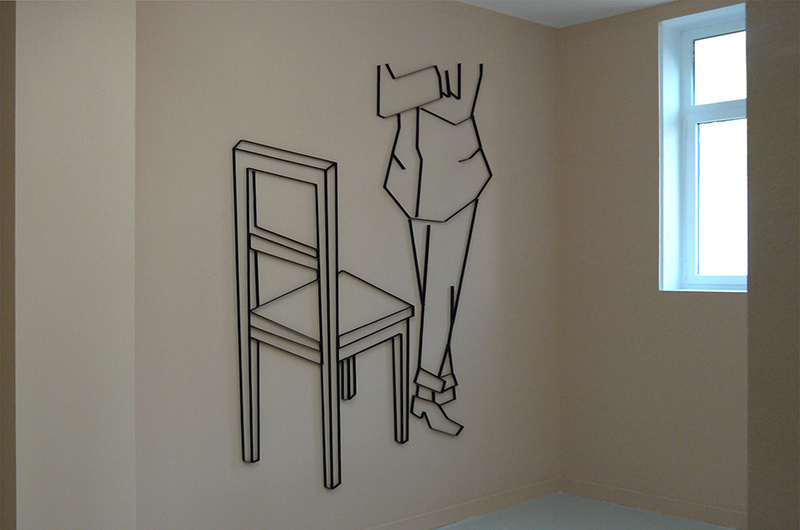
Yonatan Vinitsky
Pssst! Pssst! Just keep looking the other way… (100%), 2014
Elastique noir, Super Glue, clous
232 x 174 x 4 cm

Installation view M. QUELQUE CHOSE, Les Bains-Douches, Alençon, 2018
Jean Follain, Ola Vasiljeva, Beatriz Olabarieta, Yonatan Vinitsky
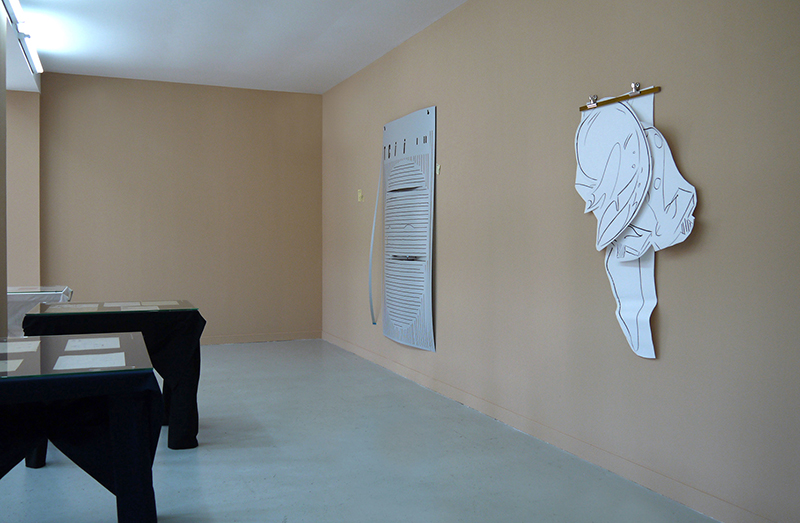
Installation view M. QUELQUE CHOSE, Les Bains-Douches, Alençon, 2018
Jean Follain, Ola Vasiljeva, Beatriz Olabarieta, Yonatan Vinitsky
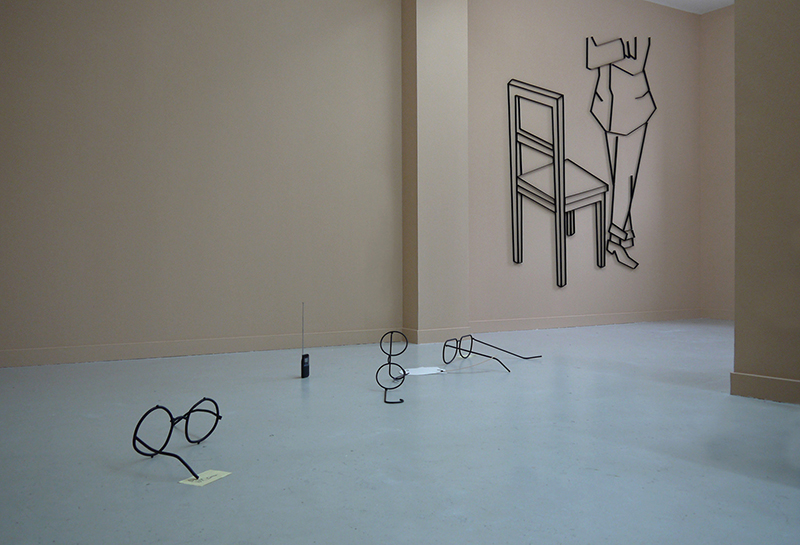
Installation view M. QUELQUE CHOSE, Les Bains-Douches, Alençon, 2018
Jean Follain, Ola Vasiljeva, Beatriz Olabarieta, Yonatan Vinitsky
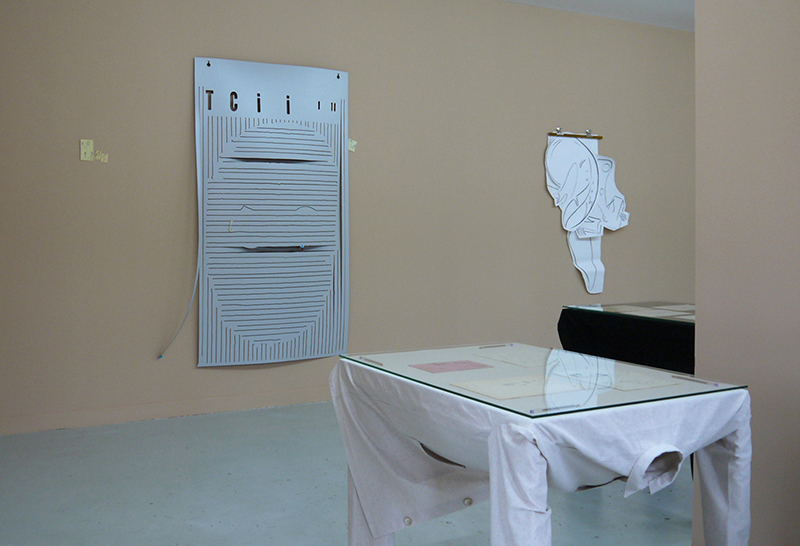
Installation view M. QUELQUE CHOSE, Les Bains-Douches, Alençon, 2018
Jean Follain, Ola Vasiljeva, Beatriz Olabarieta, Yonatan Vinitsky
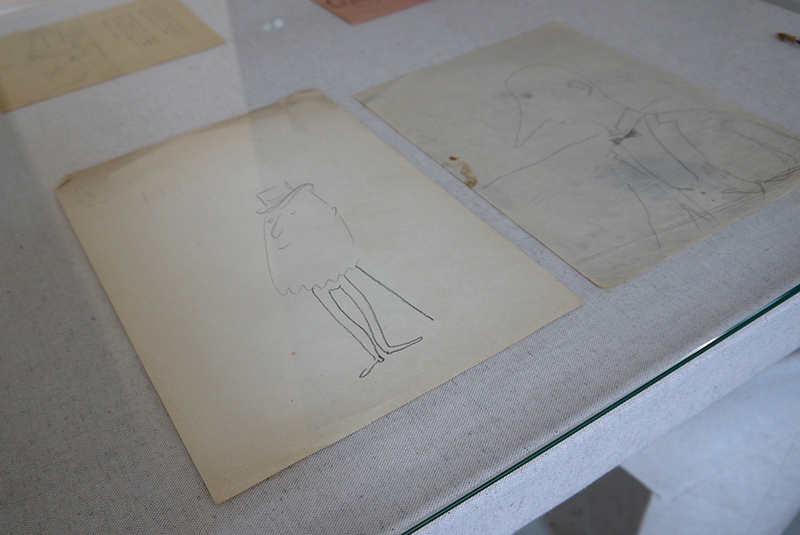
Jean Follain's drawings
Date unknown
Lown from IMEC, Caen and Musée des Beaux-Arts, Saint-Lô
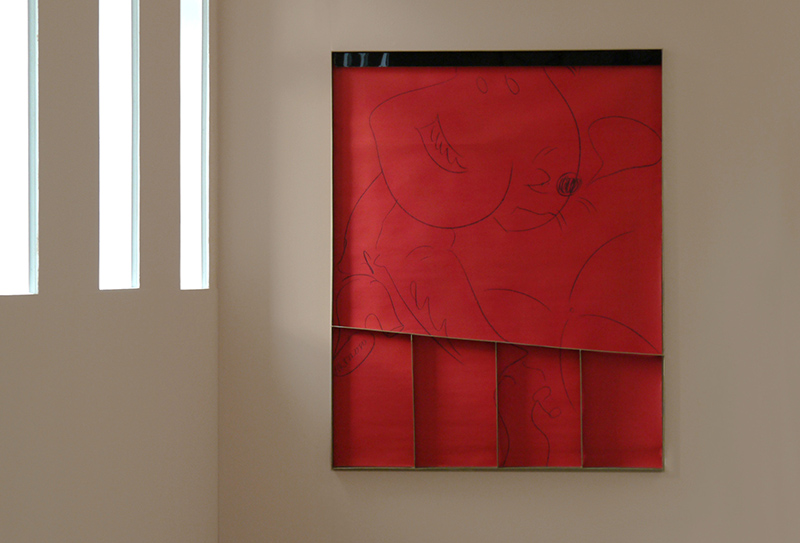
Ola Vasiljeva
Virtuoso, 2017
Fusain sur papier, métal peint, bois, époxy
150 x 120 x 4 cm

Jean Follain's drawings
Date unknown
Lown from IMEC, Caen and Musée des Beaux-Arts, Saint-Lô
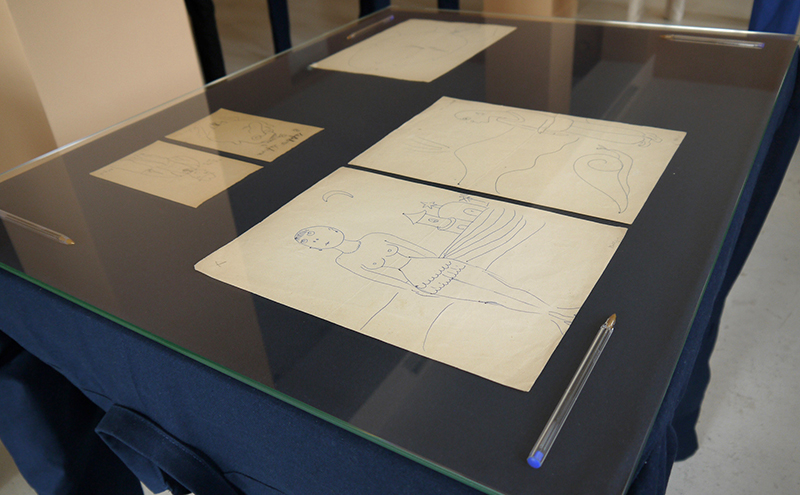
Jean Follain's drawings
Date unknown
Lown from IMEC, Caen and Musée des Beaux-Arts, Saint-Lô
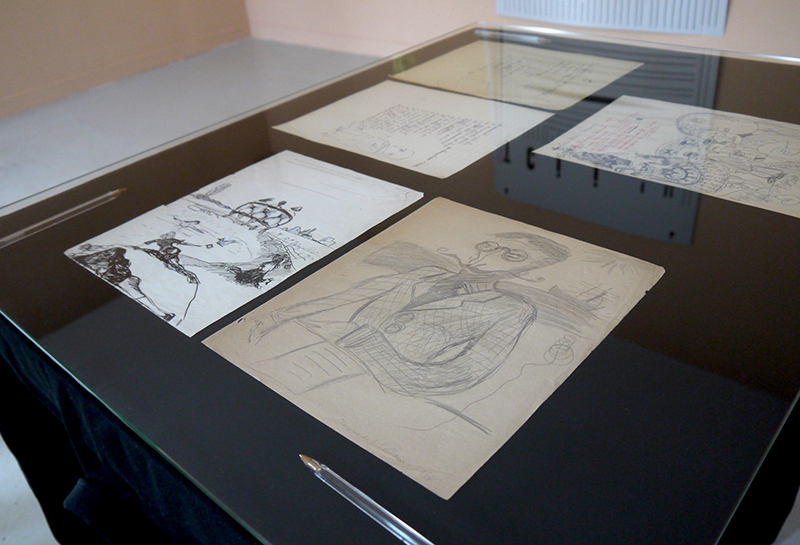
Jean Follain's drawings
Date unknown
Lown from IMEC, Caen and Musée des Beaux-Arts, Saint-Lô

Beatriz Olabarrieta
We are for viewers or heads within a head, 2017
Métal peint, vis, encre et crayon à papier sur post-its, radio
268 x 90 x 37,5 cm
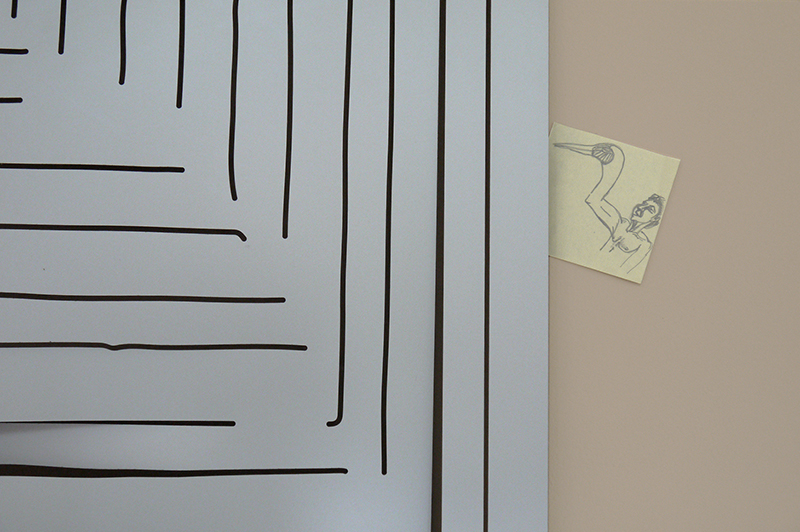
Beatriz Olabarrieta
Undercover (silver more than grey), 2017 (Detail)
Mélaminé découpé numériquement, dessins au crayon de papier sur post-its, gélatine de couleur, ruban adhésif de masquage
200 x 138,5 x 13 cm

Ola Vasiljeva
Found objects, 2016
Craie sur papiers découpés, bois, époxy
135 x 85 cm

Jean Follain's drawings
Date unknown
Lown from IMEC, Caen and Musée des Beaux-Arts, Saint-Lô
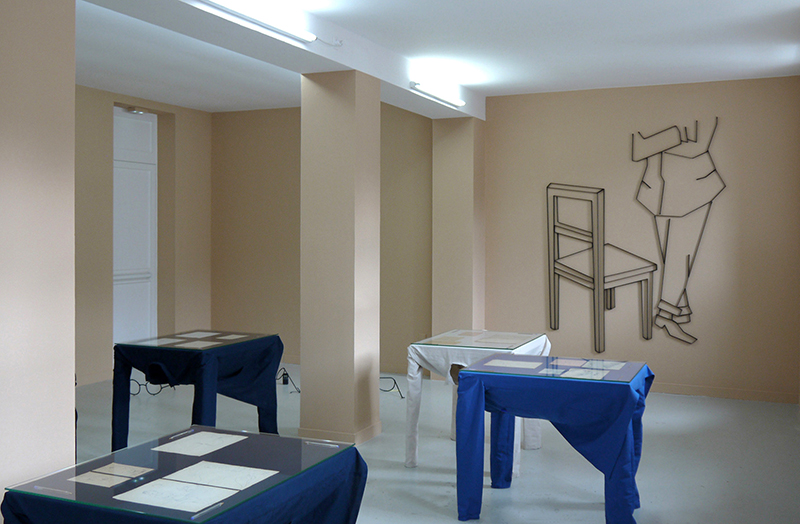
Installation view M. QUELQUE CHOSE, Les Bains-Douches, Alençon, 2018
Jean Follain, Ola Vasiljeva, Beatriz Olabarieta, Yonatan Vinitsky
